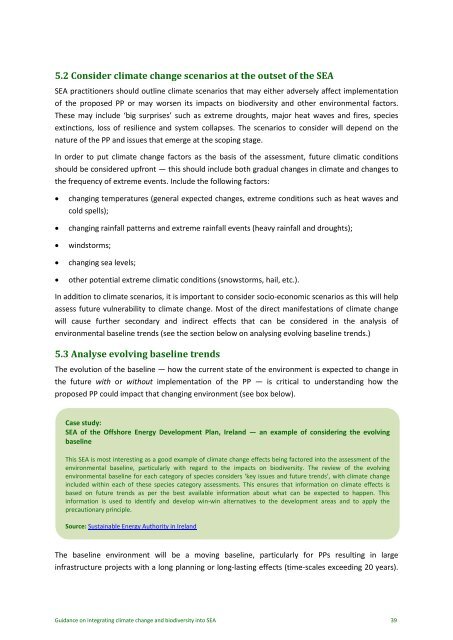Guidance on Integrating Climate Change and Biodiversity into ...
Guidance on Integrating Climate Change and Biodiversity into ...
Guidance on Integrating Climate Change and Biodiversity into ...
You also want an ePaper? Increase the reach of your titles
YUMPU automatically turns print PDFs into web optimized ePapers that Google loves.
5.2 C<strong>on</strong>sider climate change scenarios at the outset of the SEASEA practiti<strong>on</strong>ers should outline climate scenarios that may either adversely affect implementati<strong>on</strong>of the proposed PP or may worsen its impacts <strong>on</strong> biodiversity <strong>and</strong> other envir<strong>on</strong>mental factors.These may include ‘big surprises’ such as extreme droughts, major heat waves <strong>and</strong> fires, speciesextincti<strong>on</strong>s, loss of resilience <strong>and</strong> system collapses. The scenarios to c<strong>on</strong>sider will depend <strong>on</strong> thenature of the PP <strong>and</strong> issues that emerge at the scoping stage.In order to put climate change factors as the basis of the assessment, future climatic c<strong>on</strong>diti<strong>on</strong>sshould be c<strong>on</strong>sidered upfr<strong>on</strong>t — this should include both gradual changes in climate <strong>and</strong> changes tothe frequency of extreme events. Include the following factors:• changing temperatures (general expected changes, extreme c<strong>on</strong>diti<strong>on</strong>s such as heat waves <strong>and</strong>cold spells);• changing rainfall patterns <strong>and</strong> extreme rainfall events (heavy rainfall <strong>and</strong> droughts);• windstorms;• changing sea levels;• other potential extreme climatic c<strong>on</strong>diti<strong>on</strong>s (snowstorms, hail, etc.).In additi<strong>on</strong> to climate scenarios, it is important to c<strong>on</strong>sider socio-ec<strong>on</strong>omic scenarios as this will helpassess future vulnerability to climate change. Most of the direct manifestati<strong>on</strong>s of climate changewill cause further sec<strong>on</strong>dary <strong>and</strong> indirect effects that can be c<strong>on</strong>sidered in the analysis ofenvir<strong>on</strong>mental baseline trends (see the secti<strong>on</strong> below <strong>on</strong> analysing evolving baseline trends.)5.3 Analyse evolving baseline trendsThe evoluti<strong>on</strong> of the baseline — how the current state of the envir<strong>on</strong>ment is expected to change inthe future with or without implementati<strong>on</strong> of the PP — is critical to underst<strong>and</strong>ing how theproposed PP could impact that changing envir<strong>on</strong>ment (see box below).Case study:SEA of the Offshore Energy Development Plan, Irel<strong>and</strong> — an example of c<strong>on</strong>sidering the evolvingbaselineThis SEA is most interesting as a good example of climate change effects being factored <strong>into</strong> the assessment of theenvir<strong>on</strong>mental baseline, particularly with regard to the impacts <strong>on</strong> biodiversity. The review of the evolvingenvir<strong>on</strong>mental baseline for each category of species c<strong>on</strong>siders ‘key issues <strong>and</strong> future trends’, with climate changeincluded within each of these species category assessments. This ensures that informati<strong>on</strong> <strong>on</strong> climate effects isbased <strong>on</strong> future trends as per the best available informati<strong>on</strong> about what can be expected to happen. Thisinformati<strong>on</strong> is used to identify <strong>and</strong> develop win-win alternatives to the development areas <strong>and</strong> to apply theprecauti<strong>on</strong>ary principle.Source: Sustainable Energy Authority in Irel<strong>and</strong>The baseline envir<strong>on</strong>ment will be a moving baseline, particularly for PPs resulting in largeinfrastructure projects with a l<strong>on</strong>g planning or l<strong>on</strong>g-lasting effects (time-scales exceeding 20 years).<str<strong>on</strong>g>Guidance</str<strong>on</strong>g> <strong>on</strong> integrating climate change <strong>and</strong> biodiversity <strong>into</strong> SEA 39
















